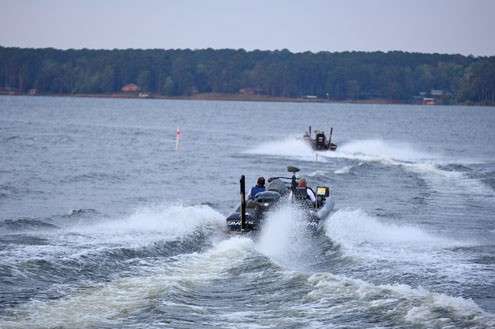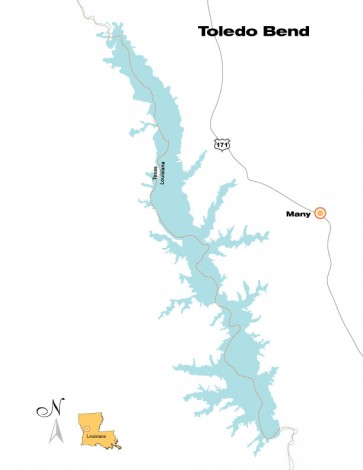
Editor’s Note: This is the fourth in a series profiling 2014 Elite Series locations.
Toledo Bend was birthed in the late 1960s, as was the Bass Anglers Sportsman Society (B.A.S.S.). This massive 185,000-acre reservoir, which straddles the Texas-Louisiana border, was part of the fishing tsunami that made professional bass tournaments a reality.
The largest lake in the South and the fifth largest in the United States, Toledo Bend was initially a flooded forest. Largemouth bass thrived in this new environment and fishermen flocked to Toledo Bend from across the country to get in on the bonanza.
The reservoir was a proving ground for many future bass pros, including Bassmaster Classic champions Tommy Martin and Harold Allen. Four time Bassmaster Classic champion Rick Clunn competed in his very first tournament ever at Toledo Bend in 1969 as a member of a bass club in Pasadena, Texas.
“Toledo Bend was an inundated forest back then,” Clunn remembers. “You couldn’t go anywhere except by following creek channels and road beds through the trees.”
Clunn fished his initial tournament in a runabout powered by an 85-hp Evinrude. A small gas kicker on the boat’s transom served as his “trolling motor.”
My how things have changed.
Much of the standing timber at Toledo Bend has broken off since, leaving vast stump fields. Pros that stray from the numerous well-marked boat lanes during the Elite tournament will risk having their outboard’s lower unit ripped off.
Although Toledo Bend looks different today, Clunn believes its bass fishery is better than ever.
“The lake doesn’t have as many bass now, but the population is more balanced,” Clunn says. “There are still plenty of bass and more bigger fish.”
The abundance of bass that weigh over 8 pounds is largely due to the introduction of Florida strain largemouths. The Texas Parks and Wildlife Division has stocked Florida largemouth bass here annually since 1990 with the exception of 2006. The Louisiana Department of Wildlife and Fisheries also stocks Florida largemouths annually.
Major spawning activity will be over when the Elite pros compete at Toledo Bend in May, Clunn points out. The bass will be chasing shad and moving out on structure.
Community Holes
 “Many of the guys will be fishing within sight of each other at proven community holes,” Clunn says. “Nowadays, with technology and GPS, there are more community holes than ever.”
“Many of the guys will be fishing within sight of each other at proven community holes,” Clunn says. “Nowadays, with technology and GPS, there are more community holes than ever.”
One area that many Elite pros will zero in on is a huge flat called Tennessee Bay. It lies just out from Cypress Bend Park in Louisiana, the official tournament site for the Elite tournament. Since nearly every major bass tournament at Toledo Bend uses this facility, Tennessee Bay is regularly supplemented with released fish.
This flat is embellished with timber, creek channels, roadbeds and drops. The past two Elite Series tournaments have been won here Clunn claims.
“The grass in this section is cyclical,” Clunn says. “The bass could be caught anywhere from 3 to 5 feet deep on the flat to 10 to 15 feet or deeper on the drops.”
When Brent Chapman won an Elite Series tournament at Toledo Bend in June 2012, his most productive lures were a 5-inch, 1 1/4-ounce silver flutter spoon and a 3/4-ounce football jig.
Some of the other prime areas that will attract the Elite pros are on the lower end of the lake, including Six Mile Creek, Housen Bay and Toro Bay. The clearer water there allows thick hydrilla beds to grow. The bass tend to be caught deeper than in the mid lake, typically 25 to 30 feet deep.
Many lures and tactics will produce enough bass to earn a check during this event, Clunn claims. However, the winner is likely to be pitching a heavy jig through hydrilla or fishing drops with deep crankbaits, big Texas rigged worms and big flutter spoons.
“It will take 14 pounds a day to make the top 50 cut,” Clunn speculates. “You’ll have to catch 17 to 18 pounds a day to qualify for the top 12. To win, you’ll need 80 pounds or so.”

